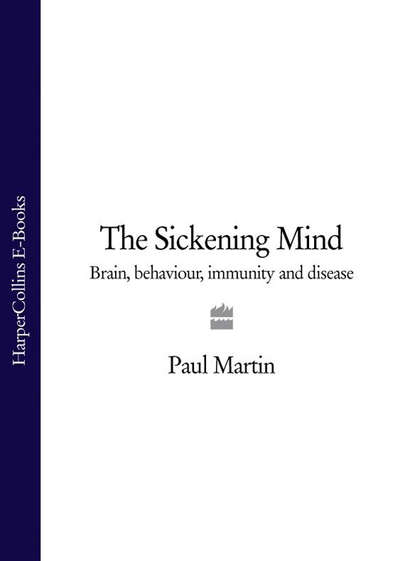По всем вопросам обращайтесь на: info@litportal.ru
(©) 2003-2024.
✖
The Sickening Mind: Brain, Behaviour, Immunity and Disease
Настройки чтения
Размер шрифта
Высота строк
Поля
(#litres_trial_promo) We shall encounter a number of these in later chapters, and I hope it will be apparent that the notions they portray do bear some relationship to the reality revealed by modern science. However, at the risk of repeating myself, let me repeat myself: the fantasies of novelists are not the same as hard scientific evidence. Fortunately, there is plenty of that as well.
Invisible worms (#ulink_df434241-fd52-5433-8ee5-bb1ad36f54d4)
O Rose, thou art sick.
The invisible worm
That flies in the night
In the howling storm,
Has found out thy bed
Of crimson joy,
And his dark secret love
Does thy life destroy.
William Blake, ‘The Sick Rose’,
Songs of Experience (1794)
The sharp divide between those who proffer psychological explanations for diseases and those who reject such theories in favour of purely physical causes is reflected in attitudes towards two particular disorders: tuberculosis and chronic fatigue syndrome.
Sir Peter Medawar, the Nobel Prize-winning immunologist and virtuoso science writer, once described tuberculosis as ‘an affliction in which a psychosomatic element is admitted even by those who contemptuously dismiss it in the context of any other ailment.’ There is abundant evidence, dating back hundreds of years, that the course and progression of tuberculosis are influenced by the sufferer’s mental state. The physical health of tuberculosis sufferers shows a tendency to deteriorate when they are subjected to severe stress or emotional upsets.
Someone who is infected with Mycobacterium tuberculosis, the bacterium that causes tuberculosis, develops a protective immune response which can hold the bacteria in check and prevent them from multiplying. The resulting stalemate between body and bacteria can mean that the disease will remain dormant for years. But if something happens to compromise or weaken the body’s immune defences, the bacteria can run riot and cause a resurgence of disease.
The importance of psychological factors in tuberculosis was widely acknowledged until well into this century. As early as 1500 BC, Hindu scripts described a wasting disease – almost certainly tuberculosis – of which one of the main causes was said to be sadness. Hippocrates, Galen and other medical luminaries of ancient Greece taught that grief, anger and other strong emotions played a major role in tuberculosis.
Throughout the seventeenth, eighteenth and nineteenth centuries many eminent European physicians stated that the causes of tuberculosis (or phthisis, as it was then known) included mental states such as ‘a long and grievous passion of the mind’, ‘a mournful disposition of the soul’, ‘ungratified desires’, ‘profound melancholy passions’ or ‘disappointment in love’. During the eighteenth and nineteenth centuries, students of tuberculosis refined the theory of a link between the disease and a specific set of psychological characteristics. This was formalized in the concept of the tuberculosis-prone personality, or spes phthisica. As we shall see later, modern science has revived the concept of disease-prone personality types with the discovery of certain intriguing associations between personality traits, heart disease and cancer.
More familiarly, we have the romantic nineteenth-century notion that consumption (as tuberculosis was then known) is caused – or, more accurately, exacerbated – by an artistic temperament. Consumptive artists or writers were believed to be consumptive primarily because of their excessive artistic and aesthetic emotions, which literally consumed them. Consumption came to be something of a status symbol among the chattering classes.
Countless noted writers, artists and musicians of the nineteenth and early twentieth centuries did indeed suffer from consumption. Emily Brontë is but one example. She died of tuberculosis, a bitterly disappointed woman, within a year of Wuthering Heights being published to withering reviews. Other creative victims of tuberculosis included John Keats, Frédéric Chopin, Robert Louis Stevenson, Stephen Crane, Katherine Mansfield, Robert Tressell, D. H. Lawrence, George Orwell and Franz Kafka. It is said that Kafka’s health was weakened by his chronic unhappiness, his hypersensitive personality, his problematic relationship with his father and several unfortunate romantic tangles. He died in an Austrian sanatorium in 1924, aged forty-one.
On the other hand, tuberculosis accounted for more than one in five of all deaths in the nineteenth century and was still common in Europe until well into this century. On statistical grounds it is hardly surprising that at least some prominent names were included among its victims.
The fiction of the eighteenth and nineteenth centuries reflects this preoccupation with tuberculosis and the prevailing attitudes towards it. We can choose from a panoply of heroes and heroines who sink into tubercular decline in the aftermath of romantic tragedy. We have, for example, the ever popular tale of La Dame aux Camélias, Alexandre Dumas the younger’s tear-jerker about the passionate but doomed love affair between Armand Duval and the enchanting courtesan Marguerite Gautier.
The young Duval meets Marguerite and is captivated by her. They become lovers. Marguerite is already consumptive, but under the healing influence of Armand’s love she abandons her dissolute lifestyle and her health improves. Meanwhile, Armand’s well-meaning father secretly persuades Marguerite that if she truly loves Armand she will leave him for his own good. Marguerite demonstrates her love for Armand by doing just that.
The cynical Armand thinks Marguerite has abandoned him out of boredom so that she can resume her former life of late nights, promiscuity and wild self-indulgence. He therefore sets out to punish her by humiliating her at every opportunity and revelling in the spectacle of her suffering:
… for the last three weeks or so, I had not missed an opportunity to hurt Marguerite. It was making her ill … Marguerite had sent to ask for mercy, informing me that she no longer had either the emotional nor physical strength to endure what I was doing to her.
As a consequence of her deep unhappiness at their separation and the psychological battering she receives from Armand, the much-wronged Marguerite goes into terminal decline. Her consumption flares up and she expires. Armand realizes his error, but not until too late.
(#litres_trial_promo) As the narrator sagely concludes: ‘I have learned that one such woman, once in her life, experienced deep love, that she suffered for it and that she died of it.’ Though Marguerite dies from tuberculosis, it is her emotions that have killed her. La Dame aux Camélias was, incidentally, modelled on Dumas’ personal experience following his affair with the courtesan Marie Duplessis. Like the fictional Marguerite, Marie died of consumption not long after the affair ended.
(#litres_trial_promo)
Until the early part of the twentieth century, popular medical literature was largely in tune with fiction in the way it emphasized the importance of psychological and emotional factors in tuberculosis. To quote one everyman’s guide to medicine from the 1930s:
Happiness is a mighty important factor in the treatment of tuberculosis … Mental brooding and loss of hope of recovery or of checking tuberculosis tends to drag the unfortunate individual into a deep chasm from which escape is rare.
So, what happened and why have attitudes changed?
What happened was that in 1882 the German scientist Robert Koch announced to the world that he had discovered the real cause of tuberculosis – the tubercle bacillus, Mycobacterium tuberculosis. Once it became known that tuberculosis was a bacterial infection, scientific interest in the role of psychological and emotional factors rapidly dwindled. The pendulum swung violently from the psychological to the physical. Open a contemporary medical text on tuberculosis and the chances are you will find little mention of psychology, emotions or the mind.
A lot of the old ideas about tuberculosis were plain wrong in their assumption that mental forces were sufficient to produce the symptoms by themselves; tuberculosis is undoubtedly a bacterial infection. Moreover, identifying a specific physical cause was immensely beneficial because it enabled medical science to find an effective remedy. Improvements in social conditions in the early twentieth century, followed by the introduction of effective antibiotics after the Second World War, led to an enormous decline in the incidence of tuberculosis in industrialized nations.
And yet it remains true that psychological and emotional factors do play a role in the disease. Later in this book we shall see how. It is not the nature of the tuberculosis that has changed, but the attitudes and interests of medical science.
CHRONIC FATIGUE SYNDROME (#ulink_1c8f4c21-6801-549b-a6e8-a4d407fe0386)
The misleading distinction between illnesses that are ‘physical’ (in other words, real) and illnesses that are ‘psychological’ (and therefore by implication not real) is starkly illuminated by the furore over chronic fatigue syndrome, otherwise known as myalgic encephalomyelitis (ME), post-viral fatigue syndrome or, if you read the tabloid press, yuppie ’flu.
It is with some trepidation that I thrust my head into the lion’s den of controversy over the causes of chronic fatigue syndrome. Fierce arguments continue to rage and the medical establishment has yet to reach any consensus. In excess of eight hundred scientific publications have been devoted to the subject and the picture changes almost weekly. Those who suffer from the illness often have passionate views about its origins and anyone who gainsays them is asking for trouble.
The debate about chronic fatigue syndrome is relevant here because it exemplifies the false dichotomy between ‘psychological’ and ‘physical’ origins of illness. Throughout the controversy runs a seductively misleading vein: the implicit assumption that the illness must be either physical or psychological in origin. But first, what exactly is chronic fatigue syndrome?
Since 1988 the term chronic fatigue syndrome (CFS) has been used to describe a debilitating illness of unknown origin that has persisted for at least six months. As you probably know (for it is often in the news) CFS is characterized by a dreadful, disabling tiredness that is made worse by any physical exertion. This fatigue is accompanied by a motley assortment of other symptoms, including general malaise, intermittent fevers, pains in the joints, stiffness, night sweats, sore throats, poor co-ordination, visual problems, skin lesions and sleep disorders.
As if that were not enough, many CFS sufferers also experience psychological problems such as severe depression, forgetfulness, poor attention and lack of concentration. CFS can persist for years and it ruins the lives of those afflicted. Often they will be forced to give up work. Sufferers may show a measure of improvement over time, but the majority remain unwell for several years.
Cases of CFS have been reported in most industrialized nations including Britain, the USA, Canada, France, Spain, Israel and Australia. Sufferers tend to be young adults between twenty and fifty, though children can also be affected. According to the American Centers For Disease Control and Prevention, more than 80 per cent of CFS sufferers are women, most are white and their average age when the illness develops is thirty. Another common factor is that sufferers usually report having contracted some form of viral infection not long before the syndrome manifested itself.
As yet, no one has come up with a truly effective remedy for CFS. None of the drugs that have been used to treat the syndrome is of proven effectiveness and some may do more harm than good.
CFS, as currently defined, is a relatively recent phenomenon. (But then, so is AIDS; the fact that a disorder has only recently been recognized and defined does not detract from its reality.) Records of vaguely CFS-like syndromes, involving severe fatigue, muscle pains and other symptoms, date back at least two centuries. The medical history books, however, contain nothing that can be unequivocally compared with CFS before the second half of the nineteenth century, when neurasthenia became a common diagnosis. Incidentally, cultural stereotypes about the sort of person who was susceptible to neurasthenia were as strong in the nineteenth century as they are now about CFS. Neurasthenia was said to be a disease of affluent middle-class women, in much the same way that CFS has been inaccurately portrayed by the popular media as ‘yuppie ’flu’, a disease of affluent thirtysomething professionals.
It was not until the first half of the twentieth century that reports of a disorder corresponding to CFS started to accumulate. The first well-documented outbreak of a CFS-like disorder occurred in the 1930s in the USA and was attributed to a mystery virus. A similar mystery ailment afflicted the staff of a London hospital in 1955, in what became known as the Royal Free epidemic. The sufferers experienced persistent muscle pain and fatigue. To begin with the syndrome was referred to as benign myalgic encephalomyelitis. By 1956, however, it had proved to be anything but benign, and so it became known simply as myalgic encephalomyelitis, or ME.
Since they first appeared on the medical map, CFS-like illnesses have gone by a baffling variety of names including epidemic neuromyasthenia, neurasthenia, Iceland disease, Royal Free disease, atypical poliomyelitis, fibrositis, fibromyalgia, post-infectious neuromyasthenia, post-viral fatigue syndrome and myalgic encephalomyelitis. It is not certain that all these illnesses have been identical with what is now referred to as chronic fatigue syndrome. An analysis of twelve well-documented outbreaks of CFS-like disorders found they differed in various respects, notably with regard to neurological problems.
Now we come to the real meat of the problem. No one yet knows for certain what causes CFS. The arguments continue to rage and there are major divisions of opinion within the medical community. But what characterizes the whole debate – especially as it is portrayed in the popular media – is the implicit distinction between physical causes, which are held to be genuine, and psychological causes, which are held to be suspect.
With a few honourable exceptions, expert opinion on CFS divides neatly into two opposing camps. In one camp are those who maintain that CFS has a physical cause such as a virus or an immunological disorder. According to this view, the depression and other psychological symptoms that characterize CFS are consequences rather than causes of the underlying physical disorder.
In the opposing camp are those who argue instead that CFS is fundamentally a psychological disorder. According to this view, the physical symptoms such as exhaustion, muscle pains, fever and malaise, are manifestations of an underlying psychiatric problem.
Which view is correct? You may not be surprised to find that both are at least partially true. Many CFS sufferers have symptoms that match the diagnostic criteria for psychiatric disorders and organic disease. The evidence is undoubtedly complex and equivocal but it points towards one conclusion: that chronic fatigue syndrome has both physical and psychological components. Let us examine some of this evidence.
Most cases of CFS are preceded by a viral infection of one kind or another, and there have been repeated suggestions that a virus might lie at the root of the syndrome. For a long time the prime candidate was the Epstein-Barr virus, a member of the herpes virus family which is also responsible for glandular fever. During the 1980s chronic fatigue syndrome was widely referred to as ‘chronic Epstein-Barr virus infection’, as though its viral origins had been firmly established. Other candidates have included retroviruses (of which HIV is an example) and polio-like viruses called enteroviruses.
There is as yet no conclusive evidence to support the viral theory and it has therefore fallen out of favour. But even if viruses are not the prime cause of CFS, it remains highly plausible that a viral infection might help to trigger or precipitate the syndrome when other causal factors are also present.








